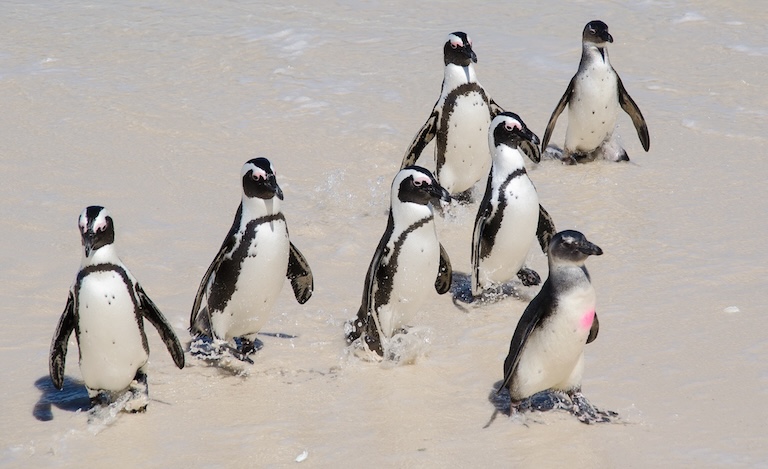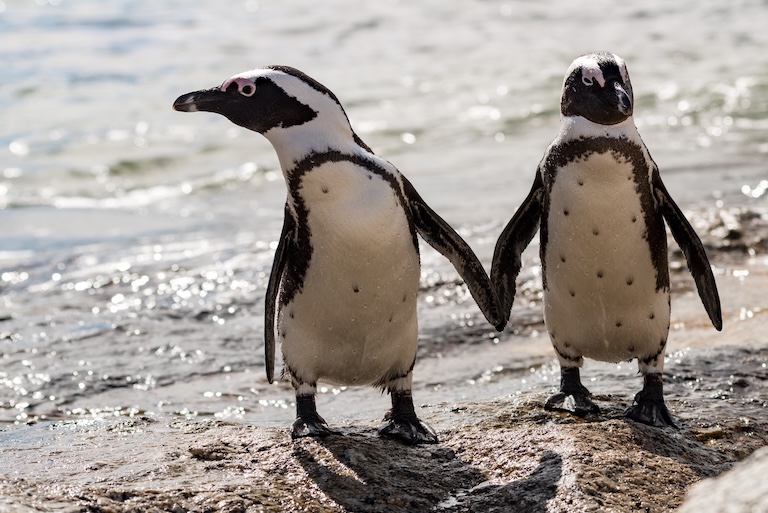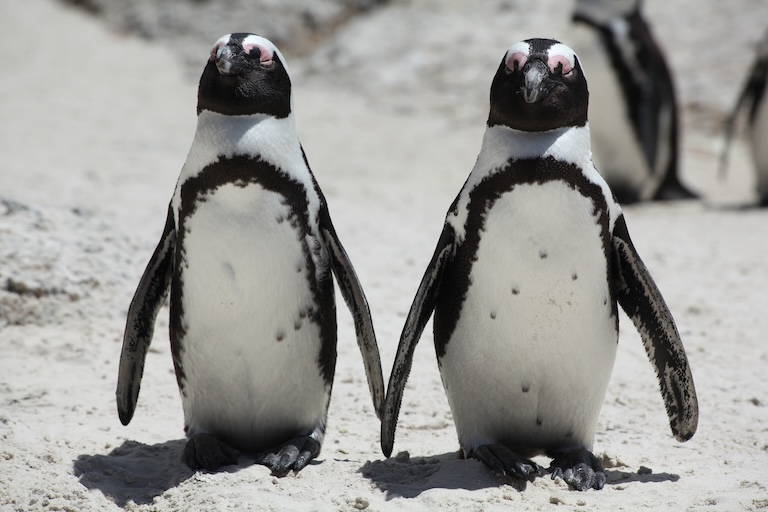African Penguin Profile
Penguins, like seals, are a lot smellier than they look. Fortunately, they’re mostly relegated to the Southernmost cap of the world, far from most people’s nostrils.
But there’s a dwindling group of exceptional penguins who, until recently were thriving on the Southern tip of Africa.
These cute little waddlers are Africa’s only endemic penguin species and are likely related to the South American species.

African Penguin Facts Overview
| Habitat: | Coastal and marine |
| Location: | Coastal southern Africa |
| Lifespan: | 25 years in the wild, 30 in captivity. |
| Size: | Up to 70cm (28 inches) tall |
| Weight: | Around 3.5kg (7.7lb) |
| Colour: | Black and white with a pink patch around the eye |
| Diet: | Fish, squid, crustaceans |
| Predators: | Seals, sharks, feral cats, caracals |
| Top Speed: | 12.4k /h |
| No. of Species: | 1 |
| Conservation Status: | Endangred (IUCN) |
African penguins were once abundant in mind-boggling numbers.
Unfortunately, not only are their eggs delicious, but so is their diet, and between egg theft and overfishing, we’ve done a great job of wiping them mostly out.
Throw in a little oiling, some feral cat introductions and increasingly bad weather due to climate change, and you end up with a tragic, endangered remnant of a once-glorious colony.
Interesting African Penguin Facts
1. They’re Jackasses
Jackass birds were put here on Earth to offer a critical public service: without them, people run the risk of getting a full night’s sleep. Every location on Earth has its jackass birds, some are lucky enough to house several.
In Northern Europe, gulls come back from the pub at 3 a.m., roaring with laughter. In Southeast Asia, the Koel yells “Oh wow!” at everything as soon as it opens its eyes. In South America, the white bellbird renditions its Foghorn Song, a deafening melody about being a diurnal animal and needing to get to work.
Sub-Saharan Africa has the Hadada Ibis, which, despite its iridescent beauty is quite literally the worst bird in the world, but where their distribution ends, on the Namibian and South African coast, that niche has been filled by the African, or Cape, penguin.
This bird is so obnoxious, it’s been officially named the Jackass penguin. Not only because it sucks to be around, but because its call resembles that of a donkey. 1

2. They moult
Most penguin species need to change their tuxedos once in a while, and all but two do this on land. Penguin moulting is not a dignified process, but it is necessary to maintain the appropriate weather-wear throughout the year.
While Antarctic species need downy Winter coats, African penguins need to adjust to the heat of the African Summer, even at sea, and this typically means everyone loses their feathers between September and January.
While breeding patterns appear to be influenced by penguin society, moutling is an environmental response, and has a high degree of synchronicity, regardless of the population densities of the birds. During this time, they’re unable to swim and look ridiculous, so they fast from food and try to stay around their nest sites where nobody can laugh at them.
This rapid, full-body moult is known as a “Catastrophic moult” and leads the penguin from the cute little ball of fluff, through the sleek hunting phase and into a sort of burst pillow stage where it can’t do very much at all. 2
3. They do well in zoos
Their ability to handle warm temperatures makes them a lot easier to look after than the refrigerated species.
They breed well in activity and adapt to outdoor enclosures. Captive populations are creating a backup population in case all of the horrible stuff we’re about to mention proves too much for the species.
African penguins are commonly found in zoos all over the world and this makes them excellent guide pigs for researchers to use penguin science on. 3
4. This allows for specific testing
While they’re awkward and clumsy on land, penguins are a lot harder to follow when they enter the water, so captive populations offer a unique insight into what they get up to.
Researchers can measure metabolic rates, dietary habits and various other metrics associated with understanding their population dynamics in an ecological context. Essentially, we get to find out how much of our food they’re eating – or rather, how much of theirs we’re taking away.
In one South African fishing location, the population of 160,000 penguins was estimated to be taking over 22 million kilos of fish per year, including roughly 8% of the average commercial anchovy catch in that area.

5. They like European seafood
This fast-food fishy diet has allowed the penguins to thrive throughout most of their history as African residents, to the point that there were once millions of individuals throughout their range.
Their favourite foods are very similar to those found in Europe: Scandinavian herring, Portuguese sardines, Italian mackerel, and Greek anchovies. Unfortunately, Europeans aren’t all that good at sharing their food.
In 1910, the number of birds aged two or older at Dassen Island was estimated to be 1.45 million. That’s ten per cent of the population of humans on the continent at the time.
Unfortunately, the problem with favouring European seafood is that it puts a species into direct competition with Europeans, and they’re quite a greedy bunch.
6. Some colonies dropped by 98%
From that flaming population in 1910 on Dassen Island, a flickering ember of only 30,000 remained by 1990. This drop represents around 98% of the population and was due in no small part to the relentless gathering of penguin eggs.
Thanks to the culture of 19th-century naturalists of sampling their own supply, we have it on record that penguin meat isn’t very nice. Sadly, the same can’t be said for their eggs.
African penguin eggs are three times the size of chicken eggs and are apparently just as good to eat. In this species, between 1900 and 1930, an average of 450,000 a year were taken from Dassen Island alone.
This tidal wave of ovicide is bad enough, but this is a species with an alarming diversity of mostly human-caused threats against it. 4
7. Oiled penguins
There’s been a chronic case of penguin oiling off the South coast of Africa and it’s not nearly as sexy as it sounds.
Various oil spills have left a constant threat to the species, and acute impacts have on occasion wiped out up to a third of the population. And even with all of this, their plight is ongoing from several more directions.
Even penguins who have been scrubbed clean and returned to the wild have a lower chance of reproduction, showing that there may be long-term behavioural or physiological effects on populations after a spill. 5
8. Food shortages are a serious problem
Overfishing comes with a wealth of deleterious effects on the environment, one of which is the necessary reduction of species who need the fish to survive.
Industrial fishing, particularly purse-seine fishing, has depleted food stocks for these penguins, to the point where even fisheries are considering the need to slow down a bit.
A lot of the fish species that remain have a lower nutritional value, which further reduces the reproductive fitness of the birds.
Climate change is also causing harm. Storm surges are increasing, and this affects the penguin’s forage abilities, both directly, and by way of reducing prey availability.
9. Even bees have been an issue
African honeybees are very aggressive. They’re the ones responsible for the “killer” genes in South American “killer bees”. So, when a hive gets knocked over, people can die.
One population of African penguins found this out the hard way when an unexplained attack led to 63 protected penguins dying from bee stings. This was pure bad luck, but the fragile position of the species as a whole meant that 63 birds were a lot to lose.
Bees aren’t commonly a problem, but this case goes to show that freak events can compound an already-struggling situation.

African PenguinFact-File Summary
Scientific Classification
| Kingdom: | Animalia |
| Phylum: | Chordata |
| Class: | Aves |
| Order: | Sphenisciformes |
| Family: | Spheniscidae |
| Genus: | Spheniscus |
| Species: | Demersus |
Fact Sources & References
- Mystic Aquarium (2018), “The African Penguin Bray – Sounds Of The Aquarium”, YouTube.
- (2015), “The awkward state of penguin molting”, Deep Sea News.
- Kenneth A. Nagy(1984), “Energy Utilization by Free-Ranging Jackass Penguins, Spheniscus Demersus”, esa.
- P.G.H. Frost (1976), “Conservation of the jackass penguin (Spheniscus demersus (L.))”, Science Direct.
- SHANNON, L.J (1999), “MANAGEMENT OF THE AFRICAN PENGUIN SPHENISCUS DEMERSUS – INSIGHTS FROM MODELLING”, Marine Ornithology.
